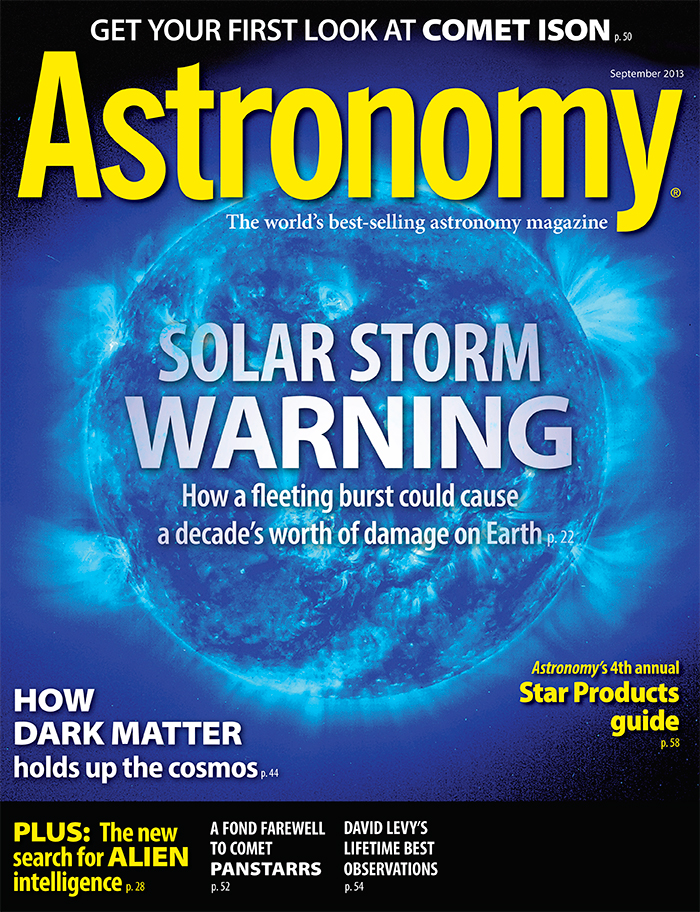
Key Takeaways:
WAUKESHA, Wis. – Despite providing us light and warmth and the general ability to exist on Earth, our Sun isn’t always a pleasant neighbor. After all, it’s a giant ball of hot gases that occasionally shoots out atomic fragments at us and the rest of the solar system. The worst are coronal mass ejections (CMEs), which can contain 10 billion tons of material and travel nearly 2,000 miles (3,200 kilometers) per second, carrying energy equivalent to the Sun’s entire output for one second. Our protective magnetosphere guards us against some of these Earth-directed outbursts, many of which produce stunning light shows in the form of aurorae. But a few managed to have wreaked temporary havoc on Earth in the form of geomagnetic storms.
In “How solar storms could shut down Earth,” Contributing Editor Bob Berman explores the impact of past solar storms and what major geomagnetic events would mean for the future. He revisits the 1989 and 2003 storms that caused localized blackouts even though these events were only “moderate solar burp[s].” Since then, scientists have studied what damage from a truly major Sun storm would be, and the numbers are staggering – including a recovery time of “three to nine additional years.”
To learn more about the impact of such solar storms and what scientists are doing to prepare Earth for a catastrophic event, pick up the September issue of Astronomy, on newsstands July 30.
“Astronomers reveal the universe’s hidden structure”
Since the 1930s, scientists have theorized that a mysterious concealed mass – aptly called “dark matter” – supplies added gravitational “glue” to hold galaxies and galaxy clusters together. And more recently, they’ve even suggested it provides an unseen scaffolding to the universe to hold up all luminous matter. But with dark matter being, well, dark, how could observations support such a theory? In “Astronomers reveal the universe’s hidden structure,” science writer Steve Nadis describes two independent studies revealing dark matter filaments in separate patches of the sky – both found in 2012.
“Get your first peek at Comet ISON”
For those with medium to large telescopes (6 inches and up), the time to start seeking out 2013’s premier celestial visitor, Comet ISON (C/2012 S1), is now. As Senior Editor Richard Talcott describes in “Get your first peek at Comet ISON,” early predictions indicate that this dirty snowball will reach 9th or 10th magnitude by late September as it treks from Cancer into Leo just north of the planet Mars. Studying it now will provide a good test to see if Comet ISON will live up to its potential as the “comet of the century” later this year.
“Astronomy‘s fourth annual Star Products”
Can’t decide on your next astronomy equipment purchase? Look no further than “Astronomy’s fourth annual Star Products.” In this special equipment review section, Contributing Editor Phi Harrington guides you through 35 of the most innovative astronomy gadgets and gizmos on the market today.
September sky events visible without optical aid
- September 1 – The Aurigid meteor shower peaks.
- September 8 – A slender crescent Moon slides by Venus and Spica.
- September 8/9 – Mars passes in front of the Beehive star cluster (M44).
- September 19 – Venus passes just south of Saturn.
- September 24 – Mercury slips just 0.8° north of Spica, the closest passage of any planet to
- a 1st-magnitude star during 2013
Also in the September 2013 Astronomy
- “The new search for alien intelligence” – Hunting for ET now involves Dyson spheres, infrared signals, and laser communications. It’s definitely not your father’s method for locating cosmic intelligence.
- “A fond farewell to Comet PANSTARRS” – The best comet in six years proved to be a superb target for astroimagers.
- “David Levy’s lifetime of observations” – Keeping a logbook is more than just a way to track your observations – it’s a written history of your relationship with the night sky. Just ask this famed comet hunter.
- “The Sky this Month” – Exclusive star charts will guide you through September’s night sky.
- The September issue of Astronomy also includes Astro News, Ask Astro, Snapshot, Breakthrough, Bob Berman’s Strange Universe, Stephen James O’Meara’s Secret Sky, Glenn Chaple’s Observing Basics, Tony Hallas’ Cosmic Imaging, Erika Rix’s Astro Sketching, Cosmic World, Letters, Web Talk, New Products, Reader Gallery, and Final Frontier.









